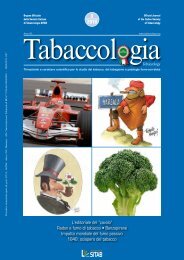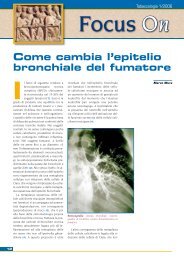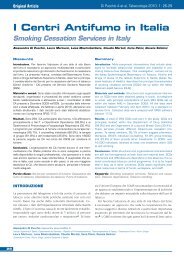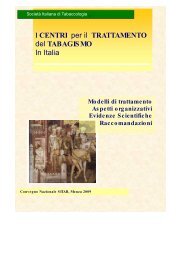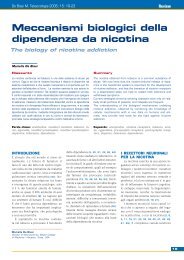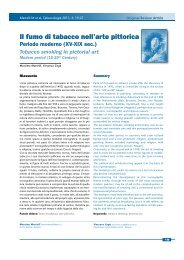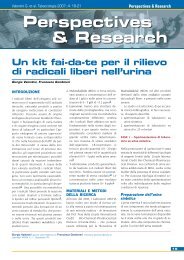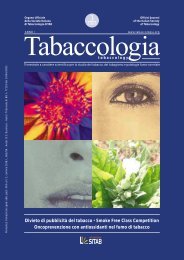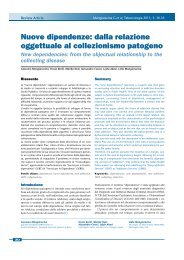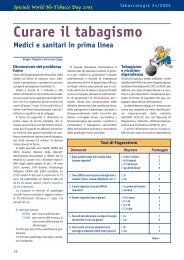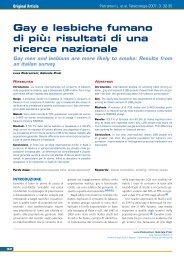Scarica n. 1/2011 - Società Italiana di Tabaccologia
Scarica n. 1/2011 - Società Italiana di Tabaccologia
Scarica n. 1/2011 - Società Italiana di Tabaccologia
Create successful ePaper yourself
Turn your PDF publications into a flip-book with our unique Google optimized e-Paper software.
30<br />
Original Article<br />
Caponnetto P et al, <strong>Tabaccologia</strong> <strong>2011</strong>; 1: 30-34<br />
effetto <strong>di</strong> un inalatore senza nicotina<br />
all’interno <strong>di</strong> un programma <strong>di</strong><br />
<strong>di</strong>suassefazione dal fumo <strong>di</strong> sigaretta<br />
effect of a nicotine-free inhalator as part<br />
of a smoking cessation program<br />
Pasquale Caponnetto, Fabio Cibella, Gabriella Papale, Davide Campagna, Giuseppe Arci<strong>di</strong>acono, Riccardo Polosa<br />
Riassunto<br />
Introduzione. I farmaci antifumo non sod<strong>di</strong>sfano le componenti<br />
comportamentali della <strong>di</strong>pendenza tabagica. L’inalatore<br />
senza nicotina è <strong>di</strong> plastica, <strong>di</strong> forma simile alla sigaretta, e<br />
rimpiazza alcuni rituali associati alla gestualità del fumare. In<br />
questo stu<strong>di</strong>o è stato esaminato per la prima volta l’effetto <strong>di</strong><br />
questo inalatore nel migliorare le percentuali <strong>di</strong> cessazione<br />
all’interno <strong>di</strong> un protocollo standard per il trattamento del<br />
tabagismo.<br />
Materiali e meto<strong>di</strong>. Alla baseline, 120 fumatori, hanno partecipato<br />
ad un programma <strong>di</strong> detossificazione dal fumo <strong>di</strong><br />
sigaretta. Sono stati stu<strong>di</strong>ati inoltre, fattori sociodemografici,<br />
livelli <strong>di</strong> depressione, <strong>di</strong>pendenza fisica e comportamentale<br />
dal fumo e motivazione a smettere. I partecipanti sono stati<br />
randomizzati in due gruppi (gruppo con inalatore e gruppo<br />
<strong>di</strong> rifermento) ed hanno effettuato due successive visite <strong>di</strong><br />
follow-up alle settimane 4 e 24.<br />
Risultati. Sul campione totale, lo stu<strong>di</strong>o non ha evidenziato<br />
<strong>di</strong>fferenze significative nei tassi <strong>di</strong> cessazione fra gruppo PAI-<br />
PO (33.3%) e <strong>di</strong> riferimento (28.3%). Tuttavia per i soggetti<br />
con alto punteggio GN-SBQ alla baseline, i tassi <strong>di</strong> cessazione<br />
alla settimana 24 nel gruppo PAIPO (66.7%) erano 3 volte<br />
più gran<strong>di</strong> comparati con quelli del gruppo <strong>di</strong> riferimento<br />
(19.2%). La regressione logistica ha in<strong>di</strong>cato un alto punteggio<br />
al GN-SBQ come forte pre<strong>di</strong>ttore <strong>di</strong> cessazione alla settimana<br />
24 nei soggetti appartenenti al gruppo PAIPO (OR =<br />
8.88).<br />
Conclusioni. L’inalatore senza nicotina può essere un utile<br />
strumento all’interno <strong>di</strong> un programma <strong>di</strong> “smoking cessation”,<br />
in particolare per quei fumatori che hanno forte <strong>di</strong>pendenza<br />
comportamentale ed il toccare e maneggiare le<br />
Pasquale Caponnetto (p.caponnetto@unict.it)<br />
Centro per la Prevenzione e Cura del Tabagismo<br />
(CPCT), Azienda Ospedaliero-Universitaria “Policlinico-<br />
Vittorio Emanuele”, Università <strong>di</strong> Catania, Catania,<br />
Italy<br />
summary<br />
Fabio Cibella<br />
Istituto <strong>di</strong> Biome<strong>di</strong>cina e Immunologia Molecolare<br />
del Consiglio Nazionale delle Ricerche, Palermo, Italy<br />
Introduction. Smoking cessation drugs are inadequate at<br />
addressing the behavioural component of tobacco dependence.<br />
Nicotine-free inhalators are plastic devices that replace<br />
some of the rituals associated with smoking gestures.<br />
The present study assessed the effect of using a nicotine-free<br />
inhalator to improve success in a standard smoking cessation<br />
program for the first time.<br />
Materials and methods. At baseline, 120 healthy smokers<br />
atten<strong>di</strong>ng a smoking cessation program were assessed<br />
for their sociodemographic factors, smoking history, ratings<br />
of depression, physical dependence, behavioural dependence<br />
and motivation. Participants were randomly assigned into<br />
two groups (nicotine-free inhalator group vs. reference<br />
group) and asked to attend two further follow-up visits on<br />
the fourth and twenty-fourth week, during which abstinence<br />
from smoking was reviewed.<br />
Results. For the whole sample, no significant <strong>di</strong>fference was<br />
found in quit rates between PAIPO (33.3%) and reference<br />
group (28.3%).<br />
However, the quit rate in PAIPO group (66.7%) was more<br />
than three-fold higher compared with the reference group<br />
(19.2%) for those in<strong>di</strong>viduals with high GN-SBQ scores at baseline.<br />
The results of the logistic model analysis in<strong>di</strong>cate that<br />
a high GN-SBQ score is a strong independent pre<strong>di</strong>ctor for<br />
successful quitting on the twenty-fourth week (OR = 8.88) in<br />
the PAIPO users.<br />
Conclusions. Nicotine-free inhalators may be beneficial<br />
when used in the context of smoking cessation interventions,<br />
particularly for those smokers for whom handling and manipulation<br />
of their cigarettes play an important part in their<br />
Gabriella Papale, Davide Campagna,<br />
Giuseppe Arci<strong>di</strong>acono, Riccardo Polosa<br />
Institute of Internal Me<strong>di</strong>cine, S. Marta Hospital,<br />
Azienda Ospedaliero-Universitaria “Policlinico-Vittorio<br />
Emanuele”, Università <strong>di</strong> Catania, Catania, Italy



